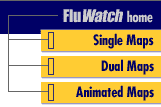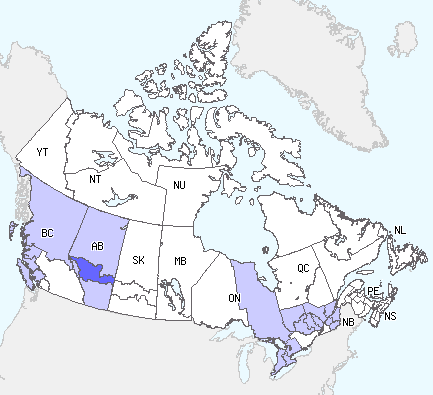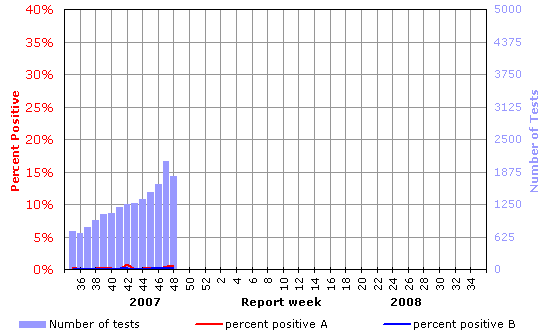Common menu bar links
E-mail this page
Fluwatch
Influenza activity remains low in Canada; ILI rate increased from previous weeks
During week 48, influenza activity levels remained low in Canada with the majority of influenza surveillance regions across the country reporting no activity (n=47). Twenty regions reported sporadic influenza activity and only 1 region (central Alberta) reported localized activity (see map). In week 48, 10 (0.6%) of the 1,789 specimens tested were positive for influenza virus. Of the influenza detections to date, 77% (40/52) were influenza A and 23% (12/52) were influenza B (see table). The ILI consultation rate increased to 16 ILI consultations per 1,000 patient visits compared to previous weeks (see ILI graph) but is still within the expected rate for this week. The sentinel response rate was low at 60%. No new outbreaks of influenza were reported this week. Since the start of the season, no new laboratory-confirmed influenza-associated paediatric hospitalizations were reported through the Immunization Monitoring Program Active (IMPACT) network.
Antigenic Characterization:
The National Microbiology Laboratory (NML) has characterized 16 influenza viruses for the 2007-2008 influenza season: 5 A(H1N1), 5 A(H3N2) and 6 B viruses. All 5 influenza A(H1N1) viruses were antigenically similar to A/Solomon Islands/3/2006 (which is the influenza A(H1N1) component recommended for the 2007-2008 influenza vaccine). Of the 5 influenza A(H3N2) viruses characterized, 4 were antigenically similar to A/Wisconsin/67/2005 (which is the influenza A(H3N2) component recommended for the 2007-2008 influenza vaccine) and 1 was antigenically similar to A/Brisbane/10/2007. One of the four A/Wisconsin-like viruses had reduced titer to A/Wisconsin/67/2005 reference antiserum. Of the 6 influenza B isolates characterized, 1 was antigenically similar to B/Malaysia/2506/2004, the B component of the 2007-2008 influenza vaccine, and 5 were antigenically similar to B/Florida/4/2006, belonging to the B/Yamagata lineage and is the B component recommended for the 2007-2008 influenza vaccine in the Southern Hemisphere (see pie chart).
Note: The results of the strain identifications indicate that there may be some degree of antigenic drift this season, however, the current Canadian vaccine is still expected to provide a level of protection against this new variant.
*The WHO recommends that the vaccines to be used in the 2007-2008 season (northern hemisphere) contain the following: an A/Solomon Islands/3/2006 (H1N1)-like virus; an A/Wisconsin/67/2005 (H3N2)-like virus; and a B/Malaysia/2506/2004-like (B/Victoria/2/1987 lineage) virus.
Antiviral Resistance:
Since the start of the season, the NML has tested 9 influenza A isolates (3 H1N1 and 6 H3N2) for amantadine resistance (from Ontario, Alberta and British Columbia). Four (44% or 4/9) of the isolates tested were resistant to amantadine, all of which were H3N2 viruses (3 originated from Ontario and 1 from Alberta) (see recommendation from the 2006-2007 influenza season below). Of the 13 isolates tested for oseltamivir resistance (9 influenza A, 4 influenza B), none were found to be resistant.
International:
WHO: During weeks 46-47, the level of overall influenza activity in the world remained low. Only sporadic activity was observed in some countries of the northern hemisphere.
CDC: A low level of influenza activity was reported in the United States during week 47 with the majority of the states reporting no activity or sporadic influenza activity only. Of the specimens tested for influenza virus, 2.0% were positive. The majority of influenza detections to date were for influenza A viruses (92%). Since September 30, 2007, CDC antigenically characterized 6 influenza isolates: 3 influenza A(H3) viruses (all A/Brisbane/10/2007-like) and 3 influenza B viruses (all belonging to the B/Yamagata/16/1988 lineage).
EISS: Influenza activity in Europe remains low. The weekly number of influenza virus detections is gradually increasing but remains low compared to previous seasons. Of the influenza virus detections to date (n=240), 33% were influenza B, 28% were influenza A not subtyped, 28% were influenza A(H1) and 6% were influenza A(H3). Based on the antigenic and/or genetic characterisation of 35 influenza viruses, 28 were A/Solomon Island/3/2006 (H1N1)-like, 6 were B/Florida/4/2006-like (B/Yamagata/16/88 lineage) and 1 was B/Malaysia/2506/2004-like (B/Victoria/2/1987 lineage). In addition, reports of RSV detections are currently increasing in Europe.
Human Avian Influenza: Since 1 December 2007, the WHO reported one new case of human infection with the H5N1 avian influenza virus from China. The case was a 24-year-old male who developed symptoms on 24 November, was hospitalized on 27 November and died on 2 December. There is no initial indication to suggest he had contact with sick birds prior to becoming unwell. Close contacts have been placed under medical observation and all remain well.
Recommendation for the Use of Amantadine for Treatment and Prevention of Influenza
The Public Health Agency of Canada does not recommend the use of amantadine for treatment or prevention of influenza for the 2006-2007 season. This recommendation will be revisited if new information becomes available.
Total number of influenza tests performed and number of positive tests by province/territory of testing laboratory, Canada, 2007-2008
| Province
of reporting laboratories |
Report
Period: November 25, 2007 to December 1, 2007 |
Season
to Date: August 26, 2007 to December 1, 2007 |
||||||
| Total
# Influenza Tests |
# of Positive Tests | Total
# Influenza Tests |
# of Positive Tests | |||||
| Influenza A | Influenza B | Total | Influenza A | Influenza B | Total | |||
| NL | 10 | 0 | 0 | 0 | 65 | 0 | 0 | 0 |
| PE | 1 | 0 | 0 | 0 | 25 | 0 | 0 | 0 |
| NS | 12 | 0 | 0 | 0 | 140 | 0 | 1 | 1 |
| NB | 10 | 0 | 0 | 0 | 139 | 0 | 0 | 0 |
| QC | 343 | 1 | 1 | 2 | 3144 | 7 | 4 | 11 |
| ON | 380 | 5 | 1 | 6 | 4541 | 16 | 2 | 18 |
| MB | 29 | 0 | 0 | 0 | 611 | 0 | 0 | 0 |
| SK | 93 | 0 | 0 | 0 | 1085 | 0 | 0 | 0 |
| AB | 862 | 1 | 0 | 1 | 7158 | 13 | 4 | 17 |
| BC | 49 | 1 | 0 | 1 | 470 | 4 | 1 | 5 |
| Canada | 1789 | 8 | 2 | 10 | 17378 | 40 | 12 | 52 |
Specimens from NT, YT, and NU are sent to reference laboratories in other provinces.
Note: Cumulative data includes updates to previous weeks; due to reporting delays, the sum of weekly report totals do not add up to cumulative totals.
Abbreviations: Newfoundland/Labrador (NL), Prince Edward Island (PE), New Brunswick (NB), Nova Scotia (NS), Quebec (QC), Ontario (ON), Manitoba (MB), Saskatchewan (SK), Alberta (AB), British Columbia (BC), Yukon (YT), Northwest Territories (NT), Nunavut (NU)
Respiratory virus laboratory detections in Canada, by geographic
regions, are available weekly on the following website:
<http://www.phac-aspc.gc.ca/bid-bmi/dsd-dsm/rvdi-divr/index-eng.php>
Number of influenza surveillance regions† reporting widespread or localized influenza activity, Canada, by report week, 2007-2008 (N=54)

![]()
† sub-regions within the province or territory as defined by the provincial/territorial epidemiologist. Graph may change as late returns come in.
Influenza
Activity Level by Provincial and Territorial |
|||||||||||||
|
|||||||||||||
Note: Influenza activity levels, as represented on this map, are assigned and reported by Provincial and Territorial Ministries of Health, based on laboratory confirmations, sentinel ILI rates (see graphs and tables) and outbreaks. Please refer to detailed definitions. For areas where no data is reported, late reports from these provinces and territories will appear on the FluWatch website. Select single maps by report week to get this updated information. Click on the map to view provinces/territories and maps for other weeks. |
|||||||||||||
Influenza tests reported and percentage of tests positive, Canada, by report week, 2007-2008
Percent positive influenza tests, compared to other respiratory viruses, Canada, by reporting week, 2007-2008

![]()
Influenza strain characterization, Canada, cumulative, 2007-2008 influenza season by the Respiratory Viruses Section at the National Microbiology Laboratory
[N=16]

{Strain characterization, number identified, per cent of total number}
NACI recommends that the trivalent vaccine for the 2007-2008 season in Canada contain A/Solomon Islands/3/2006 (H1N1)-like virus; an A/Wisconsin/67/2005 (H3N2)-like virus; and a B/Malaysia/2506/2004-like virus.
Influenza-like illness (ILI) consultation rates, Canada, by report week, 2007-2008 compared to 1996/97 through to 2006/07 seasons
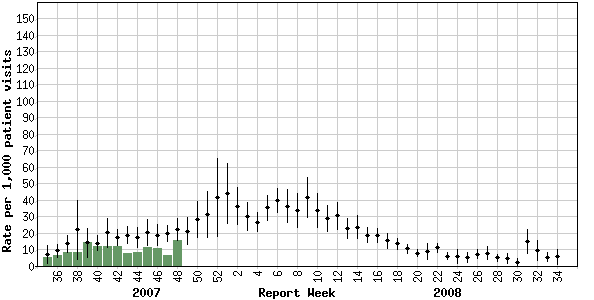
![]()
Note: No data available for mean rate in previous years for weeks 19 to 39 (1996-1997 through 2002-2003 seasons).
Number of New Outbreaks in Long Term Care Facilities, Canada, by Report Week, 2007-2008
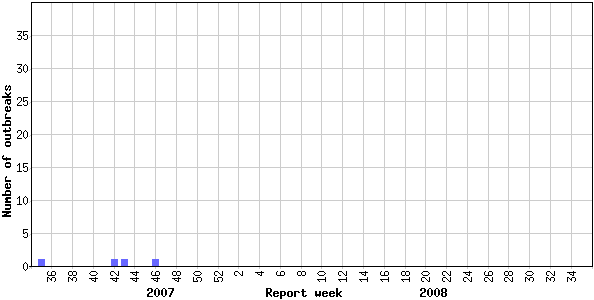
![]()
Please note that the above graphs may change as late returns come in.


